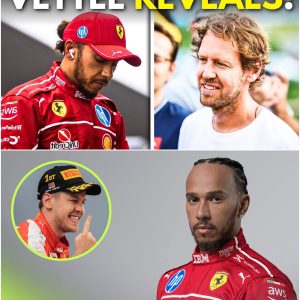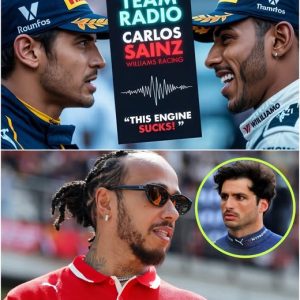Ferrari. Few names in global sport carry such an aura of history, passion, and expectation. The Prancing Horse is more than just a Formula 1 team; it is a symbol of Italy, a temple of speed, and a legend that has defined generations of racing. Yet in 2025, that legend finds itself at a crossroads, its red-painted walls echoing with whispers of internal conflict, political maneuvering, and cultural upheaval.
At the center of the storm stands Lewis Hamilton — a seven-time world champion, a disruptor, and Ferrari’s great gamble to restore past glory.
Alongside him is Charles Leclerc, the loyal Monegasque “prince” of Maranello, whose bond with Ferrari runs deep. Between them lies not just a competitive rivalry, but a clash of philosophies about what Ferrari should be in the modern age.
The Hungarian Grand Prix of 2025 has now become the latest flashpoint. What began as a routine race ended in a leaked recording that shook Ferrari to its core. A few words, spoken under the deafening roar of a Formula 1 engine, revealed a crack in the Ferrari façade that no amount of glossy marketing could conceal.

The Words That Echoed Around the World
On lap after lap around the Hungaroring, Hamilton’s voice broke through the team radio:
“I’m useless.”
Two words. Sharp, raw, and emotionally charged. To casual fans, they sounded like an admission of defeat from a champion running out of steam. To those who know Hamilton well, however, they were something else entirely. They were not resignation, but a signal of frustration — even war.
Behind the wheel at over 300 km/h, Hamilton vented not only at his struggling car but at something deeper: a sense of betrayal. His Ferrari did not feel like his Ferrari. His requests for setup changes, particularly to rear-end stability and throttle response, had been ignored in the final hours before the race. Ferrari’s strategy group overruled him, insisting on a configuration aligned with long-term development priorities rather than his immediate needs.
For Hamilton, this was more than a technical disagreement. It was proof of where the real power at Ferrari resided — not with the driver, not even with the race engineer, but with the hierarchy above, where tradition and politics still loomed large.

The Silence of Ricardo Adami
Ferrari’s veteran race engineer Ricardo Adami was the man on the other end of the radio. Normally calm, efficient, and soothing, his words are the bridge between cockpit and pit wall, the translator of data into trust. But after Hamilton’s anguished declaration, Adami paused.
It was only a heartbeat of silence, but in Formula 1, silence can be louder than words. To many observers, that moment suggested doubt, conflict, perhaps even political pressure weighing on his voice. For Hamilton, it was confirmation that the storm inside Ferrari was not just his imagination.
When the bond between driver and engineer cracks, the consequences ripple far beyond a single race. In Formula 1, communication is everything. A second’s hesitation can mean the difference between victory and defeat. More importantly, trust — that fragile currency — can define an entire season.
Hamilton vs. Leclerc: A Clash of Philosophies
The Hungarian drama was not an isolated episode but a chapter in a larger story: the collision of two identities within Ferrari.
Hamilton is a disruptor. He questions decisions, pushes for bold changes, and thrives on risk. His approach is aggressive, adaptive, and restless. Leclerc, by contrast, embodies Ferrari tradition. Smooth, loyal, precise, and deeply integrated into the team’s cautious philosophy, he has been groomed as Ferrari’s standard-bearer for years.
These contrasting styles have created not just rivalry but a cultural divide. Should Ferrari mold itself around Hamilton’s vision of innovation and risk-taking? Or should it remain faithful to the stability that has allowed Leclerc to shine?
This debate has spilled from the garage to the design office. Development paths are contested. Engineers find themselves caught between two worlds — the stability of Leclerc’s setup demands and the experimental risks Hamilton insists are necessary to dethrone Red Bull.

From Hungary to Monza: A Team on the Edge
After Hungary, Hamilton changed tack. No more frustrated radio messages. Instead, he adopted a systematic approach, gathering detailed feedback, logging every simulator session, and building a mountain of evidence to support his vision for car development. Slowly, Adami began to side more often with Hamilton in internal discussions, a subtle but powerful shift.
Some inside the garage saw this as natural — a driver and engineer growing closer. Others saw something more dangerous: the seeds of a rebellion that could reshape Ferrari’s DNA.
All roads now lead to Monza, Ferrari’s spiritual home. Here, under the sea of red banners and the deafening chants of the Tifosi, every decision will be magnified. If Ferrari prioritizes Hamilton, it will signal a bold break with tradition — an embrace of risk and disruption in the pursuit of glory. If it backs Leclerc, it will reaffirm loyalty to the philosophy that has defined Ferrari for decades.
The stakes could not be higher. Monza is not just another race. It is the Temple of Speed, the crucible where Ferrari’s identity is forged. To the Tifosi, victory is sacred, but so too is the narrative of who carries Ferrari’s hopes.
A Civil War in Red
Ferrari’s dilemma goes far beyond lap times. It is about identity, culture, and the balance between past and future.
Hamilton is not just trying to win races; he is trying to rewrite Ferrari’s DNA. His arrival in Maranello was always going to be more than just a driver transfer — it was a cultural collision. For a team often criticized for conservatism, Hamilton represents a chance to break free from history’s shadow.
Yet Ferrari is not just any team. It is steeped in tradition, bound by politics, and defined by its unique relationship with Italy itself. Leclerc embodies this continuity, a star who feels inseparable from Ferrari’s classic philosophy.
Thus, Ferrari faces its greatest challenge: can it reconcile these two forces, or will the internal conflict tear the team apart?
Beyond the Track: The Future of Ferrari
The Hungarian outburst was more than just a radio flashpoint. It was a portrait of Ferrari at a crossroads. Will it cling to tradition and stability, embodied by Leclerc, or dare to embrace the disruptive energy of Hamilton?
Red Bull, Mercedes, and McLaren watch eagerly from the sidelines, knowing that Ferrari’s internal strife may dictate the balance of power in Formula 1. For Hamilton, this battle is about legacy. Winning with Ferrari would not just be another title; it would be the ultimate triumph, cementing him as the man who restored the Prancing Horse. For Leclerc, it is about destiny — to deliver for the team he was born to lead.
As Monza looms, the answer remains uncertain. What is clear, however, is that Ferrari cannot stand still. The cheers of the Tifosi will not be patient forever.
The future of Ferrari hangs not just on aerodynamics and horsepower but on something deeper: trust, vision, and identity.
Will Ferrari unite in the storm, or fracture under the weight of its own legend? At the Temple of Speed, we may finally learn the answer.





